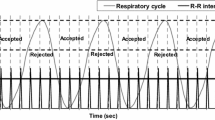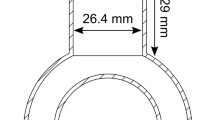Abstract
Objective
Respiratory motion is a potential cause of artefact and downgrading the quality of ECG-gated single photon emission computed tomography (SPECT) images that may result in clinical misinterpretation. We studied qualitatively the effects of respiratory motion on gated SPECT myocardial perfusion and function using Monte Carlo simulated data.
Methods
NCAT phantom was used to model a human torso. The cardiac and respiratory cycles of torso were 1 and 5 s, respectively. Eight realizations of the phantom, having diaphragmatic motion amplitudes of 0–7 cm were generated. SimSET Monte Carol simulator was used to image the phantom and generate gated studies of 16 frames per cardiac cycle.
Results
Our results demonstrated the underestimation of left ventricle end-diastolic, end-systolic, stroke volumes and ejection fraction and overestimation of wall motion and wall thickening (p < 0.01). In addition, the mean percentage of count in the basal-inferior, mid-inferior, apical-inferior, basal-septal and mid-septal segments were significantly lower due to respiratory motion when compared with control (p < 0.01). The changes in uptake were not significant in the apex, antroapical, apicoseptal, apicolateral, mid-anterior, basal-anterior, mid-lateral and basal-lateral segments.
Conclusion
Respiratory motion has significant effect on the calculation of the left ventricular functional and regional myocardial perfusion in the GSPECT. The amount of deterioration and quality distortion of the images depends on the amplitude of the diaphragmatic motion.



Similar content being viewed by others
References
Cooper JA, Neumann PH, McCandless BK. Effect of patient motion on tomographic myocardial perfusion imaging. J Nucl Med. 1992;33:1566–71.
Germano G, Erel J, Kiat H, Kavanagh PB, Berman DS. Quantitative LVEF and qualitative regional function from gated thallium-201 perfusion SPECT. J Nucl Med. 1997;38:749–54.
Go V, Bhatt MR, Hendel RC. The diagnostic and prognostic value of ECG-gated SPECT myocardial perfusion imaging. J Nucl Med. 2004;45:912–21.
Pretorius P, King MA, Tsui BM, LaCroix KJ, Xia W. A mathematical model of motion of the heart for use in generating source and attenuation maps for simulating emission imaging. Med Phys. 1999;26:2323–32.
Segars PW, Tsui BMW. Study of the efficacy of respiratory gating in myocardial SPECT using the new 4-D NCAT. IEEE Trans Nucl Sci. 2002;49:675–9.
Tsui BMW, Segars WP, Lalush DS. Effects of upward creep and respiratory motion in myocardial SPECT. IEEE Trans Nucl Sci. 2000;47:1192–5.
Wang Y, Riederer SJ, Ehman RL. Respiratory motion of the heart: kinematics and the implications for the spatial resolution in coronary imaging. Magn Reson Med. 1995;33:713–9.
Bruyant P, King MA, Pretorius PH. Correction of the respiratory motion of the heart by tracking of the center of mass of thresholded projections: a simulation study using the dynamic MCAT phantom. IEEE Trans Nucl Sci. 2002;49:2159–66.
Segars WP, Lalush DS, Tsui BMW. A realistic spline-based dynamic heart phantom. IEEE Trans Nucl Sci. 1999;46:503–6.
Zubal IG, Harrell CR, Smith EO, Rattner Z, Gindi GR, Hoffer PB. Computerized three-dimensional segmented human anatomy. Med Phys. 1994;21(2):299–302.
Haynor D, Harrison R, Lewellen T. The use of importance sampling techniques to improve the efficiency of photon tracking in emission tomography. Med Phys. 1991;18:990–1001.
He ZX, Iskandrian AS, Gupta NC, Verani MS. Assessing coronary artery disease with dipyridamole technetium-99m-tetrofosmin SPECT: a multicenter trial. J Nucl Med. 1997;38(1):44–8.
Hassan N, Escanyé JM, Juillière Y, Marie PY, David N, Olivier P, et al. 201Tl SPECT abnormalities, documented at rest in dilated cardiomyopathy, are related to a lower than normal myocardial thickness but not to an excess in myocardial wall stress. J Nucl Med. 2002;43(4):451–7.
Pitman AG, Kalff V, Every BV, Risa B, Barnden LR, Kelly MJ. Effect of mechanically simulated diaphragmatic respiratory motion on myocardial SPECT processed with and without attenuation correction. J Nucl Med. 2002;43:1259–67.
Kovalski G, Israel O, Keidar Z, Frenkel A, Sachs J, Azhari H. Correction of heart motion due to respiration in clinical myocardial perfusion SPECT scans using respiratory gating. J Nucl Med. 2007;48:630–6.
Murase K, Ishine M, Katoaka M, Itoh H, Mogami M, Iio A. Simulation and experimental study of respiratory motion effect on image quality of single photon emission computed tomography (SPECT). Eur J Nucl Med. 1987;13:244–9.
Zubal G, Bizais Y, Bennett GW, Brill AB. Dual gated nuclear cardiac images. IEEE Trans Nucl Sci. 1984;31:566–9.
Segars WP, Lalush DS, Tsui BMW. Modelling respiratory mechanics in the MCAT and spline-based MCAT phantoms. IEEE Trans Nucl Sci. 2001;48(1):89–97.
Cho K, Kumiata S, Okada S, Kumazaki T. Development of respiratory gated myocardial SPECT system. J Nucl Cardiol. 1999;6:20–8.
Beach RD, Pretorius PH, Boening G, Bruyant PP, Feng B, Fulton RR, et al. Feasibility of stereo-infrared tracking to monitor patient motion during cardiac SPECT imaging. IEEE Trans Nucl Sci. 2004;51:2693–8.
Hansen CL, Goldstein RA, Berman DS, Churchwell KB, Cooke CD, Corbett JR, et al. Myocardial perfusion and function single photon emission computed tomography. J Nucl Cardiol. 2006;13(6):e97–120.
Pretorius PH, King MA. Spillover compensation in the presence of respiratory motion embedded in SPECT perfusion data. IEEE Trans Nucl Sci. 2008;55(1):537–42.
Dodge HT, Sandler H, Ballew DW, Loard JD. Use of biplane angiocardiography for the measurement of left ventricular volume in man. Am Heart J. 1960;60(5):762–76.
Germano G, Erel J, Lewin H, Kavanagh PB, Berman DS. Automatic quantitation of regional myocardial wall motion and thickening from gated technetium-99m sestamibi myocardial perfusion single-photon emission computed tomography. J Am Coll Cardiol. 1997;30:1360–7.
Galt JR, Garcia E, Robbins W. Effects of myocardial wall thickness on SPECT quantification. IEEE Trans Med Imaging. 1990;9(2):144–50.
Sharir T, Berman DS, Waechter PB, Areeda J, Kavanagh PB, Gerlach J, et al. Quantitative analysis of regional motion and thickening by gated myocardial perfusion SPECT: normal heterogeneity and criteria for abnormality. J Nucl Med. 2001;42(11):1630–8.
Author information
Authors and Affiliations
Corresponding author
Rights and permissions
About this article
Cite this article
Bitarafan-Rajabi, A., Rajabi, H., Rastgou, F. et al. Effect of respiratory motion on quantitative myocardial gated SPECT: a simulation study. Ann Nucl Med 23, 587–593 (2009). https://doi.org/10.1007/s12149-009-0277-x
Received:
Accepted:
Published:
Issue Date:
DOI: https://doi.org/10.1007/s12149-009-0277-x




